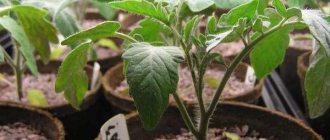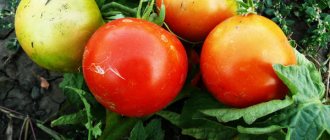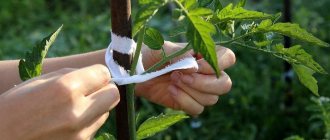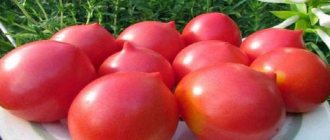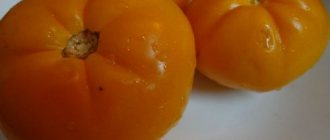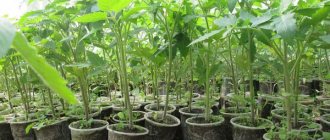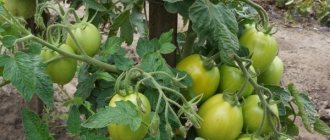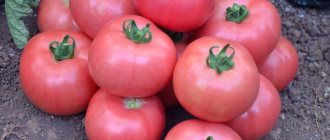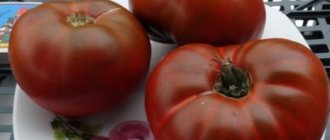Tomsk variety tomatoes appeared relatively recently and have already proven themselves to be the best.
Tomatoes of this variety are not only tasty, but also useful for the proper development of the body, as they contain essential microelements. The hybrid was produced for those areas where harsh climatic conditions are rampant.
| An important thing to remember for all vegetable growers, especially beginners! The Tomsk tomato variety is a hybrid. This indicates that the plant was obtained by crossing, and you should not collect seeds from it, since the desired result will still not be achieved. The harvest will not be rich. |
Description and characteristics of the variety
Tomato Tomsk F1 is a first generation hybrid, obtained by crossing two varieties. Such plants are particularly resistant to diseases.
Seeds cannot be collected from hybrids, since the new plants will not inherit the characteristics of the parents.
The cultivar was developed by the Dutch company Bejo Zaden BV. It was included in the State Register in 2013 and is recommended for all regions for cultivation in open ground. Produces mid-season salad fruits. From emergence to harvest, 100-115 days pass.
The plant is covered with large dark green leaves. Medium-sized bushes stop growing at a height of 1 m and require staking. The inflorescences are simple, each ripening with 4-5 large, weighty, bright red tomatoes. The average weight of the fruit is 200 g, the maximum is 270 g. They are flat-round in shape, with well-defined ribs. There is no green spot at the base.
The Tomsk hybrid has an excellent taste.
Tomatoes are suitable for preparing salads and processing into thick products. The juice from them will be dense, nutritious and sweet, with a large amount of dry matter.
Agricultural technology
The principles of growing Tomsk f1 tomatoes are similar to other varieties, but do not have certain nuances.
Tomato Persianovsky: characteristics and description of the variety
Seeds of hybrid tomato varieties do not require hardening and disinfection procedures. They already have a very high immunity to diseases of Solanaceous crops and pests.
It would be useful to carry out:
- Sorting. It will allow you to get rid of weak, empty seeds at the initial stage. To do this, you will need a saline solution (take a teaspoon of salt per glass of slightly warm water), into which the seeds are placed for 20 minutes. Poor quality seed will float to the surface, while good seed will remain at the bottom. After the procedure, the seeds should be rinsed with clean water and dried on a paper towel;
- Testing for germination - germinating seeds in damp gauze. To do this, take a plate with low sides, place gauze on it, and soak it with water. Seeds are evenly placed on top of the gauze and covered with a thin layer of cotton wool moistened with water. They should be moistened if necessary, and avoid excessive moisture and drying out.
On a note! The purchased soil mixture does not always turn out to be of high quality: who knows, maybe the manufacturer poured soil into it from a construction site, or it is pure peat. It would be safer to prepare the soil yourself.
The following is added to the soil mixture for planting seedlings:
- Peat. An indispensable component that gives looseness to the soil, absorbs moisture and perfectly retains it;
- Sand or perlite. Be sure to use only coarse, clean river sand. Used as a leavening agent;
- Leaf soil. Gives the soil lightness and looseness;
- Humus. Only well rotted;
- Sawdust is an excellent substitute for peat and sand.
Tomsk seeds are sown in prepared soil in the first half of March, covered with film and removed in a warm place before sprouts appear. After which the film is removed, and the seedlings are placed in a well-lit room. There should be regular watering.
Attention! It is better to use soil from the area where the seedlings will grow - this will speed up the establishment process.
Picking is carried out after the formation of the first 2 leaves. Late picking is possible, after 3-4, but there is a possibility of poor survival of the tomato and its weak immunity.
Forty-day-old seedlings can be planted in open ground, according to the scheme - 40x60 cm.
Note. Seeds begin to germinate at a temperature of +12…+14°C.
The Tomsk tomato loves loose, porous, light, fertile and living soil that can absorb moisture well and retain it, with a normal level of acidity.
Necessary conditions for growing in open ground:
- No more than 2-3 plants per 1 square. m;
- Standardization of flowers;
- Pinching the inflorescences, leaving 4-5 ovaries on them, and preferably 3 - then the fruits will be large and uniform;
- Regular weed removal;
- Stepsonning;
- Removing the lower leaves;
- Regular watering, as the top fertile layer of the soil dries, using only warm, settled barrel water.
Despite good frost resistance, the Tomsk f1 tomato is a heat-loving crop. However, temperatures above +32°C negatively affect the viability of pollen grains and the efficiency of photosynthesis.
The Tomsk tomato variety needs to provide a high level of light so that all stages of vegetative growth occur with maximum efficiency, since the tomato is very light-loving.
Mandatory Garter
Tomsk is a variety of tomatoes that require mandatory tying to a support and pinching.
On a note. It is recommended to form a plant with 2-3 stems when grown in open ground conditions. For a greenhouse, it is better to form a bush with 1-2 stems.
Fertilizing is not a prerequisite for growing tomatoes, and many gardeners ignore it, but it certainly affects the yield of tomatoes. The better you feed the plant, the greater the result will be obtained. You can't overdo it either.
Feeding:
- On the 21st day after planting, the seedlings are fertilized with nitrogenous substances, which promote the growth of greenery. After 3 days, the bushes are watered at the root with a solution of urea (1 tbsp per 10 liters of water);
- When the first flowers appear, the plant is fed with potassium. Chicken manure in the form of a solution is perfect (0.5 liters of manure per bucket of water);
- When flower clusters appear, feed them with potassium humate;
- 14 days after the 3rd feeding, superphosphate is used.
If necessary, fertilizing can be carried out during the period of fruit formation.
Tomato Tomsk reviews photo yield
Garden
Description and characteristics of tomato Tomsk F1, reviews, photos
Mid-season, medium-sized, large-fruited tomato for greenhouses and open ground. This hybrid was specially created for cultivation in difficult natural and climatic conditions.
The bush is of a determinate type, up to 1 meter high in the greenhouse and slightly higher in the greenhouse. Requires tying to the support and pinning. The manufacturer recommends forming the plant into 2-3 stems.
Fruit characteristics
The fruits of tomatoes of the Tomsk F1 variety are quite large in size. The average weight of the fetus reaches 250 grams. The shape of the fruit is flat-round. Externally they are smooth, shiny and dense. The color is rich red. Tomatoes are distinguished by high taste and pleasant aroma. The fruit is juicy and moderately fleshy, with a light and pleasant sourness. The fruit contains a large amount of sugars.
See also
Description of the tomato variety Logan and its characteristicsRead
This variety of tomato is suitable for preparing salads, other various dishes, and for canning. They are also suitable for preparing tomato juices, ketchups, and tomato paste. Freshly picked tomatoes are ideal for eating in their pure form.
Healthy! After harvesting, the fruits are stored for up to 15 days without losing their taste. They also tolerate transportation well, remaining dense.
Advantages
Thus, the main advantages of this varietal variety of tomatoes include the following:
- High taste qualities;
- Large (up to 300 grams) fruit sizes;
- Resistance to diseases and pests;
- Possibility of storage and transportation;
- Easy to grow both under film or in a greenhouse, and in open ground.
Such positive characteristics allow us to classify Tomsk F1 as a premium class variety.
The description of the hybrid Tomsk F1 makes it clear that such tomatoes can and should be grown in your summer cottage. Flattering reviews from vegetable growers about these tomatoes are another reason to purchase seeds. They are usually purchased in specialized stores, and can also be ordered by mail or online.
Features of growing Solokha tomatoes, planting recommendations
Sowing the seeds of this tomato for seedlings is carried out 60-65 days before the intended planting in the ground.
When planting seedlings in a permanent place per 1 sq. Up to 6 plants are placed per meter of the prepared area. If you grew Solokh tomatoes, please write whether you liked them or not. What was the yield and taste of the fruit? Has this variety become your favorite? Is this variety ideal for pickling? If possible, attach a photo of the entire bush as a whole or individual fruits you grew. Thank you!
Your reviews of the Solokha tomato and additions to the description will help many gardeners evaluate this variety objectively and decide whether it is worth planting or not.
Among gardeners you can often find those who have planted a Solokha tomato at least once. Next, the characteristics and description of the variety are presented.
Description of the variety Tomsk F1
Tomsk F1 is a new product on the Russian market. What is the Tomsk F1 hybrid tomato? It is grown both in greenhouses and in open ground. Tomsk F1 can safely be classified as a mid-season variety. Already 75 days after planting the seedlings in the ground, it becomes possible to enjoy the taste of the fruit.
Tomato bushes are of a determinate type. The height of the bushes often reaches 1 meter, so there is a need to tie the bushes to a support.
Interesting! One of the advantages of the varietal species is its high resistance to various diseases.
Features of cultivation and care
When planted in regions with temperate and cool climates, this Siberian tomato requires minimal care. In the south, it is better not to plant a variety at all, but to choose another one. The Siberian Troika bears fruit there, but the yield and quality of the products leave much to be desired.
Sowing seeds
Seeds are sown 55 or 60 days before transplanting to a permanent location. The timing depends on the region and climate characteristics. Gardeners will have to calculate the exact date themselves.
When grown in the soil of the Middle Zone, seeds are planted from mid to late March. For greenhouses - in the first and second ten days of the month.
In the North-West, in the Siberian regions, the deadlines are shifted by 7-10 days. To grow the variety in open beds, sow seeds from early to mid-April, in protected ground - in the second half of March.
By the time of planting in the greenhouse, the soil should warm up to 10° C. Tomatoes are placed in open ground when there is no fear of return frosts, and the soil temperature will rise to 15° C.
The Urals are usually warmer than cold areas. But the climate there is too changeable and unpredictable. When sowing seeds and moving tomatoes to a permanent place, you should focus on the Siberian regions. It is better to get the harvest a week later than to lose all the seedlings due to a sudden frost.
Features of outdoor care
One of the main advantages of Siberian Troika tomatoes when grown in garden beds is that they require almost no care. The bushes need to be watered and periodically fed, and preventive treatments should be done.
But it is not necessary to plant the variety. It branches weakly anyway. But everyone’s soil and care are different, the bushes need to be monitored, and if they become too thick, they need to be thinned out. Otherwise, fungal diseases may develop, although the tomato has good resistance to them.
Usually it is enough to remove some of the long, very large leaves; it is they that thicken the bush when there are few stepsons. You just need to remove only those under the brush that has already begun to paint. In the second half of summer, new stepsons are plucked out - anyway they will not produce a harvest.
Formation of a bush in greenhouses
In protected soil, allowing tomatoes to grow as they please is an unforgivable waste; space should be saved. Although the Siberian Troika does not need to remove stepsons in the beds, in greenhouses tomatoes grow in 1-3 trunks.
The overall yield does not change. Simply, as the number of tomatoes increases, the weight of each individual fruit decreases. Here you should focus on your own needs. If you need 250-350 g tomatoes, leave 1 stem. When weight does not matter, or vegetables are intended for whole-fruit canning, you can leave 3.
The Siberian troika must be tied up. Moreover, in greenhouses the bush easily reaches 1.2 m.
